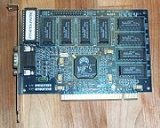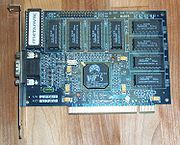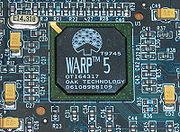
Oak Technology
Encyclopedia
Oak Technology was a supplier of semiconductor
chips for sound cards, graphics cards and optical storage devices such as CD-ROM
, CD-RW
and DVD
. In 2003, it was acquired by Zoran Corporation.
Oak Technology helped develop the ATAPI standard and provided the oakcdrom.sys CD-ROM
driver that was ubiquitous on DOS
-based systems in the mid-1990s.
In 1994, Sun Microsystems
decided to change the name of their new language from Oak
to Java
because Oak was already trademarked by Oak Technology.
8-bit VGA chipset, with up to 256KB of DRAM. Provided support for VGA, EGA & CGA diaplay modes. Most are only able to do standard VGA modes.
(ie. up to 320x200x256 and up to 640x480x16).
OTI057/067
ISA SVGA chipsets. Supports up to 512KB of DRAM (usually 70/80 ns).
OTI077
Enhanced version of the OTI067. Includes support for 1MB and up to 65Mhz dot-clock.
Capable of resolutions up to 1024x768x256 colors in Non-Interlaced mode, and up to 1280x1024x16 colors Interlaced.
OTI087
One of the first VLB chipsets available. Has a 16-bit external data path, and a 32-bit internal memory-controller data path. It features some acceleration hardware: register-based color expansion, hardware cursor, primitive BitBLT engine, 4-bit graphic latch and some other new (for its time) features. Maximum BIOS resolutions are 1024x768x256 Non-Interlaced and 1280x1024x256 interlaced. Maximum Dot-Clock is 80Mhz, but is usually coupled with the OTI068 clock generator capable of frequencies up to 78Mhz. This chipset supports up to 2MB of 70/70R ns DRAM.
Spitfire - OTI 64105/64107
64-bit DRAM chipset. Very rare.
Spitfire - OTI 64111
64-bit PCI/ISA 2D chipset. DRAM and EDO supported. Very Rare.
Eon - OTI 64217
Supports EDO
and SGRAM. PCI chipset, 64-bit memory bus.

 During the late 1990s, Oak was developing their first and only 2D/3D graphics accelerator chip. Warp 5 was to be a tile-based deferred renderer (TBDR), similar to PowerVR
During the late 1990s, Oak was developing their first and only 2D/3D graphics accelerator chip. Warp 5 was to be a tile-based deferred renderer (TBDR), similar to PowerVR
's chipsets. In the same vein as the S3
ViRGE
chip, the Warp 5 was pin-compatible
with a 2D-only predecessor. The chip was never released because ATI
acquired the technology. It was Oak's final mainstream graphics chip development effort.
This graphics processor was based on a region concept and had many similarities to Microsoft's Talisman
architecture. The chip processed each region at a time and did on chip z-sorting and anti-aliasing
. As a result, the chip did 24-bit floating point
Z, sub-pixel anti-aliasing, order independent translucency, non-linear fogging and atmospheric effects and MIP-Mapping
. Typically, such region based architectures are gated by the number of polygons that can be processed per region, but Oak claimed that there were no such limitations in the WARP 5.
Semiconductor
A semiconductor is a material with electrical conductivity due to electron flow intermediate in magnitude between that of a conductor and an insulator. This means a conductivity roughly in the range of 103 to 10−8 siemens per centimeter...
chips for sound cards, graphics cards and optical storage devices such as CD-ROM
CD-ROM
A CD-ROM is a pre-pressed compact disc that contains data accessible to, but not writable by, a computer for data storage and music playback. The 1985 “Yellow Book” standard developed by Sony and Philips adapted the format to hold any form of binary data....
, CD-RW
CD-RW
A CD-RW is a rewritable optical disc. It was introduced in 1997, and was known as "CD-Writable" during development. It was preceded by the CD-MO, which was never commercially released....
and DVD
DVD
A DVD is an optical disc storage media format, invented and developed by Philips, Sony, Toshiba, and Panasonic in 1995. DVDs offer higher storage capacity than Compact Discs while having the same dimensions....
. In 2003, it was acquired by Zoran Corporation.
Oak Technology helped develop the ATAPI standard and provided the oakcdrom.sys CD-ROM
CD-ROM
A CD-ROM is a pre-pressed compact disc that contains data accessible to, but not writable by, a computer for data storage and music playback. The 1985 “Yellow Book” standard developed by Sony and Philips adapted the format to hold any form of binary data....
driver that was ubiquitous on DOS
DOS
DOS, short for "Disk Operating System", is an acronym for several closely related operating systems that dominated the IBM PC compatible market between 1981 and 1995, or until about 2000 if one includes the partially DOS-based Microsoft Windows versions 95, 98, and Millennium Edition.Related...
-based systems in the mid-1990s.
History
Oak Technology, Inc was founded in 1987. During the late 1980s through the early 1990s, Oak was a supplier of PC graphics (SVGA) chipsets and PCBs. Oak Technology also supplied mother board chipsets - a PS2 compatible chipset and the Oaknote chipset for notebooks. Oak enjoyed modest success in the value segment (low-end) of the market, but without an effective Windows accelerator, ultimately failed to remain competitive.In 1994, Sun Microsystems
Sun Microsystems
Sun Microsystems, Inc. was a company that sold :computers, computer components, :computer software, and :information technology services. Sun was founded on February 24, 1982...
decided to change the name of their new language from Oak
Oak (programming language)
Oak was a programming language created by James Gosling in 1991, initially for Sun Microsystems set-top box project. The language later evolved to become Java.The name Oak was used by Gosling after an oak tree that stood outside his office.-History:...
to Java
Java (programming language)
Java is a programming language originally developed by James Gosling at Sun Microsystems and released in 1995 as a core component of Sun Microsystems' Java platform. The language derives much of its syntax from C and C++ but has a simpler object model and fewer low-level facilities...
because Oak was already trademarked by Oak Technology.
Products
OTI037C8-bit VGA chipset, with up to 256KB of DRAM. Provided support for VGA, EGA & CGA diaplay modes. Most are only able to do standard VGA modes.
(ie. up to 320x200x256 and up to 640x480x16).
OTI057/067
ISA SVGA chipsets. Supports up to 512KB of DRAM (usually 70/80 ns).
OTI077
Enhanced version of the OTI067. Includes support for 1MB and up to 65Mhz dot-clock.
Capable of resolutions up to 1024x768x256 colors in Non-Interlaced mode, and up to 1280x1024x16 colors Interlaced.
OTI087
One of the first VLB chipsets available. Has a 16-bit external data path, and a 32-bit internal memory-controller data path. It features some acceleration hardware: register-based color expansion, hardware cursor, primitive BitBLT engine, 4-bit graphic latch and some other new (for its time) features. Maximum BIOS resolutions are 1024x768x256 Non-Interlaced and 1280x1024x256 interlaced. Maximum Dot-Clock is 80Mhz, but is usually coupled with the OTI068 clock generator capable of frequencies up to 78Mhz. This chipset supports up to 2MB of 70/70R ns DRAM.
Spitfire - OTI 64105/64107
64-bit DRAM chipset. Very rare.
Spitfire - OTI 64111
64-bit PCI/ISA 2D chipset. DRAM and EDO supported. Very Rare.
Eon - OTI 64217
Supports EDO
EDO
Edo may refer to:* Edo, the historical name for Tokyo, Japan* Edo Aircraft Corporation, a defunct American company that primarily designed aircraft floats* Edo language, a language spoken in Nigeria* Edo period, in Japanese history...
and SGRAM. PCI chipset, 64-bit memory bus.
Warp 5
Warp 5 - OTI 64317

PowerVR
PowerVR is a division of Imagination Technologies that develops hardware and software for 2D and 3D rendering, and for video encoding, decoding, associated image processing and Direct X, OpenGL ES, OpenVG, and OpenCL acceleration....
's chipsets. In the same vein as the S3
S3 Graphics
S3 Graphics, Ltd is an American company specializing in graphics chipsets. Although they do not have the large market share that they once had, they still produce graphics accelerators for home computers under the "S3 Chrome" brand name.-History:...
ViRGE
Virge
A virge, from the Latin virga, is a type of rod, made of wood.Originally it was one or more branches used as an instrument for corporal punishment, or as a riding crop.It is presently best known as the ceremonial staff of the Anglican...
chip, the Warp 5 was pin-compatible
Pin-compatibility
In electronics, a pin-compatible device, such as a logic integrated circuit , memory module or microprocessor, is one that has the same functions assigned to the same particular pins....
with a 2D-only predecessor. The chip was never released because ATI
ATI Technologies
ATI Technologies Inc. was a semiconductor technology corporation based in Markham, Ontario, Canada, that specialized in the development of graphics processing units and chipsets. Founded in 1985 as Array Technologies Inc., the company was listed publicly in 1993 and was acquired by Advanced Micro...
acquired the technology. It was Oak's final mainstream graphics chip development effort.
This graphics processor was based on a region concept and had many similarities to Microsoft's Talisman
Microsoft Talisman
Talisman was a Microsoft project to build a new 3D graphics architecture based on quickly compositing 2D "sub-images" onto the screen, an adaptation of tiled rendering. In theory, this approach would dramatically reduce the amount of memory bandwidth required for 3D games and thereby lead to...
architecture. The chip processed each region at a time and did on chip z-sorting and anti-aliasing
Anti-aliasing
In digital signal processing, spatial anti-aliasing is the technique of minimizing the distortion artifacts known as aliasing when representing a high-resolution image at a lower resolution...
. As a result, the chip did 24-bit floating point
Floating point
In computing, floating point describes a method of representing real numbers in a way that can support a wide range of values. Numbers are, in general, represented approximately to a fixed number of significant digits and scaled using an exponent. The base for the scaling is normally 2, 10 or 16...
Z, sub-pixel anti-aliasing, order independent translucency, non-linear fogging and atmospheric effects and MIP-Mapping
Mipmap
In 3D computer graphics texture filtering, MIP maps are pre-calculated, optimized collections of images that accompany a main texture, intended to increase rendering speed and reduce aliasing artifacts. They are widely used in 3D computer games, flight simulators and other 3D imaging systems. The...
. Typically, such region based architectures are gated by the number of polygons that can be processed per region, but Oak claimed that there were no such limitations in the WARP 5.
- The specifications included:
- 50m pixels/sec (all features turned on)
- EDODynamic random access memoryDynamic random-access memory is a type of random-access memory that stores each bit of data in a separate capacitor within an integrated circuit. The capacitor can be either charged or discharged; these two states are taken to represent the two values of a bit, conventionally called 0 and 1...
and SGRAMDynamic random access memoryDynamic random-access memory is a type of random-access memory that stores each bit of data in a separate capacitor within an integrated circuit. The capacitor can be either charged or discharged; these two states are taken to represent the two values of a bit, conventionally called 0 and 1...
Memory Supported - 8MB - On-chip Texture CacheCacheIn computer engineering, a cache is a component that transparently stores data so that future requests for that data can be served faster. The data that is stored within a cache might be values that have been computed earlier or duplicates of original values that are stored elsewhere...
- 2D GUIGuiGui or guee is a generic term to refer to grilled dishes in Korean cuisine. These most commonly have meat or fish as their primary ingredient, but may in some cases also comprise grilled vegetables or other vegetarian ingredients. The term derives from the verb, "gupda" in Korean, which literally...
acceleration - Video Scaling in Y
- VBI support Including Intercast
- 220MHz RAMDACRAMDACRandom Access Memory Digital-to-Analog Converter is a combination of three fast DACs with a small SRAM used in computer graphics display adapters to store the color palette and to generate the analog signals to drive a color monitor...
- Resolutions to 1600 X 1200
- Direct3DDirect3DDirect3D is part of Microsoft's DirectX application programming interface . Direct3D is available for Microsoft Windows operating systems , and for other platforms through the open source software Wine. It is the base for the graphics API on the Xbox and Xbox 360 console systems...
and BRender APIApplication programming interfaceAn application programming interface is a source code based specification intended to be used as an interface by software components to communicate with each other...
s supported - OS support Windows 95Windows 95Windows 95 is a consumer-oriented graphical user interface-based operating system. It was released on August 24, 1995 by Microsoft, and was a significant progression from the company's previous Windows products...
and Windows NTWindows NTWindows NT is a family of operating systems produced by Microsoft, the first version of which was released in July 1993. It was a powerful high-level-language-based, processor-independent, multiprocessing, multiuser operating system with features comparable to Unix. It was intended to complement... - Packaging - 256 pin BGABGABGA can refer to:* Bach-Gesellschaft Ausgabe, the first complete edition of the works of J.S. Bach* Ball Grid Array, a type of surface-mount packaging used for integrated circuits* Battle Ground Academy, a private school in Franklin, Tennessee, USA...
- Pin CompatibilityPin-compatibilityIn electronics, a pin-compatible device, such as a logic integrated circuit , memory module or microprocessor, is one that has the same functions assigned to the same particular pins....
with OAK OTI-74217 EON 2D GUI accelerator
External links
- http://list.driverguide.com/list/company745/ - some drivers for Oak graphics cards

